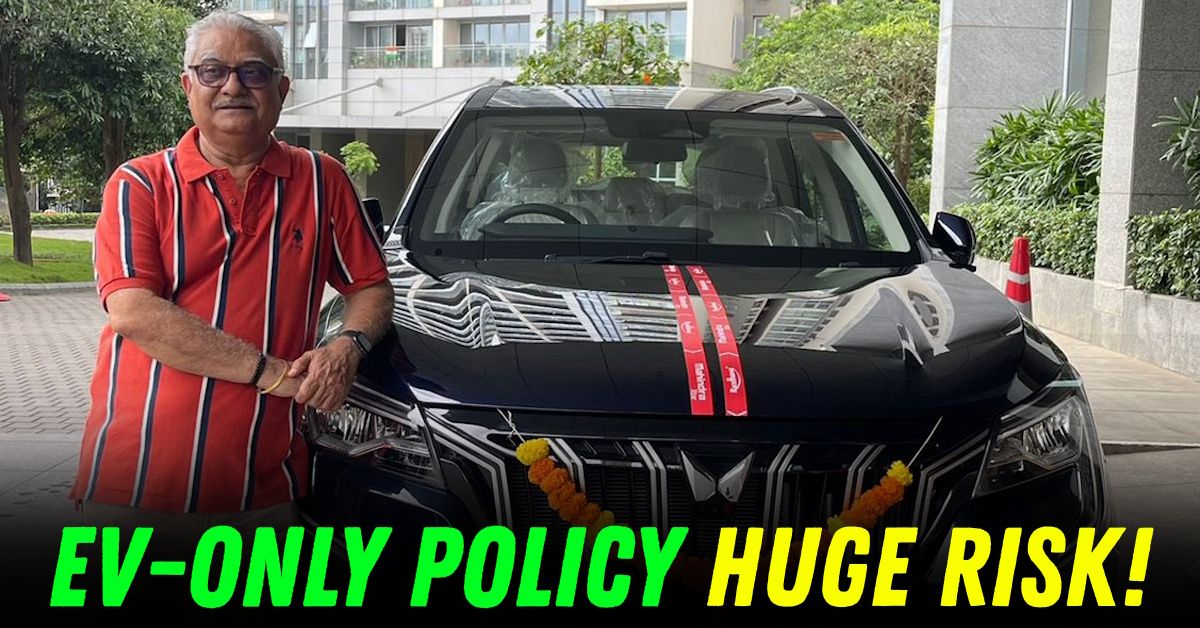Ex-Mahindra Boss To Heavy Industries Minister: EV-Only Policy Is Very Risky For India


A former senior executive from one of the country's leading automakers - Rajan Wadhera - Ex-President At Mahindra & Mahindra, has written to Heavy Industries Minister H.D. Kumaraswamy. In the letter, Mr. Wadhera has warned about the potential pitfalls of pursuing an aggressive electric vehicle-only strategy, highlighting serious concerns about infrastructure readiness, financial risks to domestic manufacturers, and dangerous dependence on Chinese supply chains.
Mr Rajan Wadhera wrote,
Pursuing an aggressive EV-only strategy without securing robust and diversified supply chains may inadvertently deepen our strategic dependence on a nation that has often taken positions adverse to India’s geopolitical and economic interest.
While the trade restrictions may appear uniform on the surface, China’s actions often vary depending on the country, guided more by geopolitical calculus than trade fairness. Given its growing strategic alignment with Pakistan, including military supplies, this should be a serious cause of concern for India.
Biofuels, for instance, not only reduce emissions but also support farmer incomes and enhance energy security.
The warning comes as the government prepares to launch applications for its flagship EV manufacturing policy, which offers reduced import duties to global automakers willing to invest in local production. However, industry insiders are questioning whether the ambitious push towards electrification might be moving too fast for the country's current capabilities.
The government's latest EV incentive programme promises to slash import duties to 15 percent on electric cars priced above $35,000, provided manufacturers invest at least ₹4,150 crore in local manufacturing within three years. Yet early signs suggest the policy may struggle to attract major players, with Tesla already indicating it has no plans to manufacture locally and will instead rely on imports from its Berlin facility.
The exclusion of Chinese giant BYD due to geopolitical concerns further limits the policy's appeal, leading many to describe it as potentially being a non-starter for pure-play EV manufacturers. This leaves the programme largely dependent on legacy automakers who have yet to prove their electric vehicle credentials in their home markets.
Perhaps the most pressing concern raised by industry veterans relates to charging infrastructure. The country currently operates just 25,000 charging stations nationwide, serving a ratio of one public charger for every 135 EVs. Meeting the government's target of 3.9 million chargers by 2030 would require unprecedented coordination between public and private sectors, along with massive capital investment.
The challenge extends beyond mere numbers. Poor road conditions, extreme temperatures, and inadequate service support networks could significantly compromise EV performance, particularly for global manufacturers unfamiliar with local operating conditions. These infrastructure gaps pose real barriers to widespread adoption, regardless of policy incentives.
Even modest EV adoption could pose financial threats to established automakers. If electric vehicles reach just 25 percent of total sales, traditional manufacturers heavily invested in internal combustion engine technology could face significant financial strain unless they successfully adapt their business models.
This concern is particularly acute for domestic manufacturers like Tata Motors and Mahindra, who have invested heavily in EV development but now face the prospect of competing against subsidised imports.
The situation has created tension within the industry, with EV-focused companies opposing any extension of benefits to hybrid vehicles, while manufacturers like Maruti Suzuki and Toyota argue for a more inclusive approach.
The electrical infrastructure presents another formidable challenge. Achieving 25 percent EV adoption could increase electricity demand by nearly 60 percent, requiring substantial upgrades to the national power grid. Without careful planning, this surge in demand could overwhelm existing capacity and potentially negate some environmental benefits if met through coal-powered generation.
As many as 6.7 million new charging points may be needed by 2030, requiring innovative policy solutions such as time-of-use tariffs to encourage off-peak charging and prevent grid overload.
Industry insiders have also raised concerns about the strategic implications of rapid EV adoption, particularly regarding dependence on Chinese supply chains for critical components and batteries. This dependency creates vulnerability in a sector the government views as strategically important, especially given ongoing border tensions and trade concerns.
The former Mahindra executive's warning reflects broader industry sentiment that a more measured approach might serve the country's interests better. Rather than pursuing an EV-only strategy, many advocate for a technology-neutral policy that encourages innovation across multiple clean mobility solutions, including hybrids and alternative fuels.
Current EV penetration stands at approximately 8 percent, growing at roughly 200 basis points annually. To reach the government's 30 percent target by 2030, this growth rate would need to nearly double to 380 basis points per year. A challenging proposition given existing constraints.
The path forward requires addressing fundamental infrastructure gaps, ensuring domestic manufacturers can compete effectively, and developing a robust electrical grid capable of supporting widespread electrification. Without these foundations, even the most generous policy incentives may fail to deliver the transformation the government envisions.
As applications for the new EV manufacturing policy prepare to open, the industry watches nervously to see whether policymakers will heed these warnings or press ahead with an ambitious timeline that may prove premature for current market conditions.
Via FinancialExpress